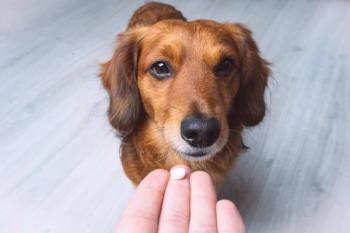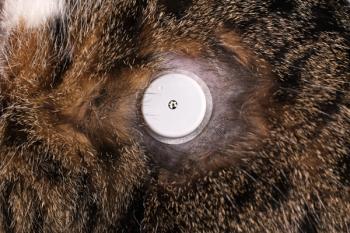
- dvm360 May 2019
- Volume 50
- Issue 5
Cloning: A new reproductive tool for equine veterinarians
By duplicating high-performance and defect-free animals, the horse industry is discovering new ways to mold the genetics of the equine population.
In March of 2018, 60 Minutes reporter Leslie Stahl broadcast a story on Argentina's Adolfo Cambiaso, the top-rated polo player in the world, and his use of cloning to “duplicate” elite polo ponies.
The first horse ever cloned was in 2003 through the use of technology similar to that used on Dolly the sheep, the first mammal to be cloned from adult and not embryonic cells.
In 2006, Cambiaso's most prized horse, Aiken Cura, fractured his leg and had to be euthanized. “Before doing so,” Stahl said in the segment, “Cambiaso asked his veterinarian to save some of the horse's skin cells, thinking technology would evolve and he could bring Aiken Cura back to life through cloning.”
Cambiaso partnered with wealthy polo enthusiast Alan Meeker of Texas, who according to Stahl had long dreamed of building a fleet of champion horses. In 2009, Meeker founded a horse-cloning business based in Argentina, and a year later they sublicensed technology from ViaGen, the exclusive global licensee of the cloning technology that was used to create Dolly.
According to the 60 Minutes story, “From that point, Cambiaso and Meeker joined forces to clone some of the finest polo ponies in Argentina and worldwide.”
Their initial efforts resulted in the birth of a foal clone to Cambiaso's beloved Aiken Cura. “The foal grew into this magnificent healthy horse, almost exactly like his genetic duplicate, having his strength, athleticism, agility and temperament,” Cambiaso told Stahl. In order to be sure, he took some hair from the clone and confirmed that the DNA matched that of Aiken Cura exactly.
Cambiaso also decided to clone his biggest polo star, a mare called Cuartetera. He eventually created more than a dozen clones of Cuartetera. “From those little points [skin cells from a spot on her neck], we made all those horses,” Cambiaso said proudly.
The clones are not exactly identical to the original; for example, the white markings on the bodies of the Cuartetera clones are different in shape and location on the body. But all her clones seem to have inherited Cuartetera's calm, self-contained temperament.
The clones don't seem to have any special health issues. “We talked to scientists at the NIH,” Stahl reported. “We were told that there's no evidence that cloned animals suffer disproportionate health problems, though they have a slightly higher infant mortality rate.”
According to the 60 Minutes piece, Cambiaso's team now creates 100 clones per year, and they use them in their breeding business. They mate the clones with championship horses and sell the foals for up to $250,000. But they do not sell the clones themselves, a business strategy that lets them keep the original DNA to themselves.
Though cloning is allowed within most horse breed registries, it's banned for racing thoroughbreds and quarter horses. Even so, thoroughbreds and quarter horses are regularly cloned and participate in disciplines such as dressage, polo and rodeo.
The cloning procedure
Tailor Fit was a two-time AQHA World Champion racehorse. Photo courtesy of Blake Russell.ViaGen Equine in Cedar Park, Texas, bills itself as the global leader “in bringing horse cloning technology to the world's innovative horse owners.” ViaGen has cloned hundreds of elite horses, including ViaGen President Blake Russell's stallion Pure Tailor Fit.
ViaGen produces cloned foals for clients around the world, shipping horses annually to Europe and other regions. The company markets its genetic preservation and cloning services as a tool in the equine practitioner's toolbox of reproductive capabilities. Through cloning, horse owners and their veterinarians can produce foals that are genetically identical to the original horse.
The process begins with a biopsy of the horse chosen for cloning. After receiving the ViaGen kit, a veterinary practitioner takes multiple small (4- to 6-mm) biopsy punches, predominantly skin with a small amount of tissue below the skin. The area is then sutured with one or two stitches. “The procedure is so mild, quite often horses are biopsied and compete on the same day,” states Russell. The biopsy is then placed in the ViaGen kit and shipped to the company's cell culture lab in Cedar Park.
“In a period of about two to three weeks we're able to take the set of biopsy punches and convert them into a cell line of literally millions of cells that each have the DNA necessary to produce an ‘identical twin' of that donor animal,” Russell explains. As a precaution, ViaGen preserves the cell line in multiple vials and stores it in multiple locations.
The cells have a life well into the future. “I don't think there's data to show that it's guaranteed forever,” Russell says, “but still, we've cloned from cell lines that have been stored for more than 20 years.”
Once a client decides to move forward with cloning, ViaGen thaws the cell line and places the DNA into an enucleated oocyte. The oocytes can be obtained commercially from unknown mares or can be collected in vivo. Once the oocyte has received its new genetic material, ViaGen conducts its proprietary process to activate fusion and begin embryo development.
In horses, ViaGen is able to culture the embryo in an incubator for six days, which allows them to assess its development. The embryo is then graded based on phenotype and transferred to surrogate mares according to routine embryo transfer protocols. From that point forward, the process is essentially the same as a conventional equine embryo transfer at the seven-day stage. The mare gestates for 330-plus days.
After foaling, the mare and foal remain at Timber Creek Veterinary Clinic, a ViaGen-affiliated veterinary hospital, for observation and care until the client is able to inspect the foal. Normally these foals remain at Timber Creek for 30 to 60 days. This also allows for DNA from the foal to be sent to a third party for verification that it's a match to the donor animal.
Finally, the foal is transported to its owner, either with the surrogate mare or after weaning.
An expanded genetic impact
Sixteen years ago, when ViaGen started cloning horses, the technology was relatively new. The company's interest was to clone proven breeding animals to help horse owners magnify the value of their horses' genetics-especially the females. The thought was that outstanding mares have a limited ability to contribute to the population, since they can have a foal only once a year or so.
Cloning in cattle
Genomics is rocking the food production world-and so is cloning, says ViaGen President Blake Russell.
Through genomics-the analysis of an animal's DNA-producers can identify elite animals without observing them for their entire productive life. This genetic technology is now being used extensively for both beef and dairy cattle. And it fits perfectly with reproductive technologies such as cloning, Russell says.
“A few days after a calf is born, they can approximate its value based on its genomics,” he continues. “A dairy producer might wait years for a very high-end, high-genomic heifer. Now that producer can replicate a high-genomic calf via cloning and have multiples. That's a very rapidly growing segment of our industry.”
In beef cattle, geneticists have been able to identify various genetic defects that affect productivity. “ViaGen is often called on to provide cloning services for those breeding animals who are free from the known genetic defects in order to clean up a population,” Russell says.
This is similar to what's happening in horses. “We continue to identify some of these genetic defects across the horse population,” Russell says. “With the ability to bring ‘clean' geldings or ‘clean' mares back into the breeding pool, we can have clean genetics without sacrificing performance.”
“We give these mares an opportunity to provide a larger genetic dose to the breeding population. Cloning expands an elite mare's impact,” Russell states.
ViaGen also realized that cloning enabled them to work with geldings, which are obviously unable to reproduce. Colts with an unruly temperament are often gelded early in life, and some go on to have a terrific performance career. Cloning allows these horses to be “stallions” again, able to pass on their genetics to future generations of horses.
When mares and geldings expanded the size of the potential cloning market, the horse industry found itself with a new technology. “ViaGen has clients that are interested in both the reproductive and performance potential in their elite animals,” Russell says.
Still, there are no guarantees of a champion career. “Cloning is receiving very positive feedback,” Russell says. “But most horse breeders understand that genetics are just one part of that equation. We can reproduce the genetic potential, but performance is a combination of genetics and environment. A performance champion needs both.”
Of course, some people simply want to duplicate a horse they had a special relationship with. Though that's a relatively small portion of the cloning market, it's growing in popularity, ViaGen says.
What clients want
“I think it's really important that people realize that cloning is just another advanced breeding technology,” says Gregg Veneklasen, DVM, of Timber Creek Veterinary Hospital, a ViaGen-affiliated veterinarian and expert on cloning and embryo transfer. “Though the technology is 20 years old, today there are hundreds of clones.”
“Cloning has become the norm for our practice-another tool in our toolbox regarding reproduction in horses,” he says. “The procedure is not any different than being able to do embryo transfer. The clones are made from vitrified cells, thawed, and the embryos are put in the surrogate mare's uterus, which is my portion of the procedure.”
Cloning has been an extensive part of Dr. Veneklasen's journey in his 36 years as a veterinarian. “I've seen horses, through single trait selection, lose many important traits associated with reproduction and soundness,” he says. “Cloning is a way to utilize elite horses from our past that demonstrate desirable traits for today and can reintroduce traits of interest such as long-term soundness, reproductive fitness, etc.”
The bottom line, Dr. Veneklasen says, is that cloning is a tool equine practitioners can use-and it works! “If that's what the client wants, then I think that's what we're all about,” he says. “Each client may have a unique reason for why cloning is the best answer for them.”
Ed Kane, PhD, is a researcher and consultant in animal nutrition. He is an author and editor on nutrition, physiology and veterinary medicine with a background in horses, pets and livestock. Kane is based in Seattle.
Articles in this issue
over 6 years ago
Alane Cahalane: Saving moon bears and caring for Hong Kongs petsover 6 years ago
Taxpayer-funded kitten slaughter to end, USDA saysover 6 years ago
Commentary: Veterinarians need better boundariesover 6 years ago
How to know if your veterinary hospital needs a CT scannerover 6 years ago
Just Ask the Expert: An alternative to Clavamox Drops?over 6 years ago
Will New York law change veterinary malpractice?over 6 years ago
DVM needed: A look at the associate veterinarian shortageNewsletter
From exam room tips to practice management insights, get trusted veterinary news delivered straight to your inbox—subscribe to dvm360.




